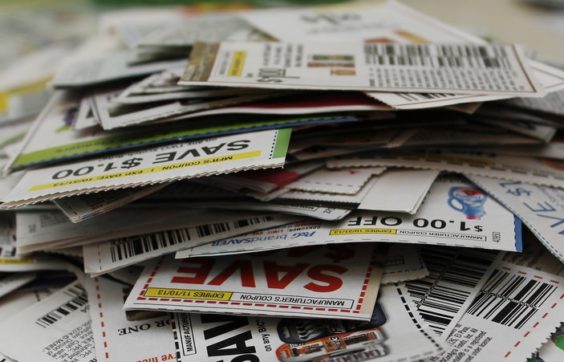Coupons in the News turned five this year, after publishing more than 1,600 unique and original news stories about the coupons you use and the stores in which you use them.
But that milestone was only one highlight this year – the world of couponing itself was busy as ever. So before you ring in the new year, we invite you to take a few moments to look at the top ten stories of 2017, and how they could affect the way you use coupons in the year to come:
10. Coupon fraudster pays a steep price
He was once a key player in a coupon industry he derided as a “lying, cheating, dirty business”. Today, he’s inmate #08784-089 at the Oklahoma City Federal Transfer Center.
Following Chris Balsiger’s conviction late last year, the decade-long International Outsourcing Services saga officially came to an end in March of this year. That’s when the former coupon processing company CEO was sentenced to 10 years in prison, was ordered to pay $65 million in restitution to more than two dozen coupon-issuing manufacturers, and was penalized an additional $21 million.
Balsiger was found to have falsely submitted some $250 million worth of coupons to manufacturers for reimbursement that were never actually used by shoppers, keeping the cash for his company and himself.
Balsiger’s request for a retrial was denied in September, and now he’s pursuing an appeal. This long-running story appears to be over – but if Balsiger has his way, the epilogue hasn’t been written just yet.
9. Target’s Perks go poof
Proponents of digital coupons and promotions prefer them because they’re “fraud-proof”.
Try telling that to Target, which pulled the plug on its fraud-plagued Cartwheel Perks program over the summer. The program, introduced to limited areas back in 2015, was meant to be a fun way to reward loyal customers with free items through Target’s Cartwheel app. Instead, scammers figured out ways to reward themselves.
Some determined users spoofed their cell phone locations in order to gain access to the program, then signed up for multiple accounts and sold them on social media to others who wanted in. Others shared ways to misuse their reward coupons on items for which they were not intended. Still others took screen grabs of their bar codes and sold them to others who could scan them and get free stuff, without being Perks members at all.
Target has introduced a number of mobile innovations this year, merging its Cartwheel app into the main Target app, and adding a mobile payment capability. But it no longer has a loyalty program.
Target representatives took issue with the mere suggestion that the fraud had anything at all to do with its decision to end Cartwheel Perks. But if the program was wildly successful and impervious to fraud, it’s hard to imagine Target dumping it so unceremoniously.
Thanks, scammers.
8. The fight against coupon fairies
They fought the coupon company – and the coupon company won.
Two lawsuits initiated in 2016 were resolved this year, both resulting in serial printable coupon abusers being banned for life from Coupons.com.
Coupons.com owner Quotient Technology sued a couple of “coupon fairies”, both of whom had devised ways to bypass the website’s two-print limit to generate an unlimited number of unique coupon prints, which they then made available for sale online.
The defendants tried to put up a fight, arguing that they were just taking advantage of a vulnerability that Quotient was well aware of. Quotient, they said, should have spent more time shoring up its systems and less time trying to make an example out of two of the hundreds or thousands of coupon fairies doing the very same thing.
Ultimately, the fairies folded and chose not to see Quotient in court. Both agreed to permanent bans on printing any coupons from Coupons.com, and one was also ordered to pay Quotient $113,091 in damages, attorneys’ fees and costs.
In the meantime, Quotient has made some changes to its systems, and coupon fairies are not nearly as active as they once were – though you can still find printable coupons for sale online if you look for them. At least until the sellers find themselves the target of another lawsuit.
7. Coupon use is way down. Again.
Two years ago, coupon use hit a historic low point. Last year, it was even lower. This year, there were signs that by the time year-end figures are released next month, it could plummet even further.
Apparently we’re couponing like it’s 1975 again.
According to new figures released by Inmar this year, the coupon redemption rate reached its lowest point in more than four decades, for the second year in a row.
Part of it is likely due to that old standby complaint – coupons just aren’t as good as they used to be. But there are other theories. We’re buying more prepared foods and meal kits, and fewer products that offer coupons. We’re also doing more shopping at discount stores and online, where manufacturer’s coupons aren’t accepted.
Those trends don’t appear to be slowing down. So the days of “non-extreme couponing” may be here to stay.
6. Rebate apps reach their expiration date
If the first half of this decade was all about the rise of the rebate app, the second half of the decade has been about the survival of the fittest.
The alcohol rebate app bevRAGE folded this year. So did the grocery app Snapstar. Shopmium was discontinued, as its features were incorporated into the Coupons.com app. And no one’s really sure exactly what’s going on with Mobisave.
The world of cash-back apps seems to be coalescing around Ibotta, Checkout 51 and SavingStar, as the market leaders push out the pretenders. There are still other apps trying to make inroads, though, like Makeena, Fetch Rewards, and a yet-to-be-publicly-announced rebate app that’s set to make an “official” debut early in the new year.
There are only so many times most of us are willing to scan receipts, and only so many apps we’re willing to upload them to, before the whole process becomes cumbersome and just not worth the trouble. So the upstarts had better have something good to offer – otherwise, they may go the way of the others that found they just couldn’t compete.
5. No double-dipping – for real
You can still save a lot with the rebate apps that remain. But if you’re tired of uploading the same receipts to multiple apps in order to double up on rebate offers – a couple of apps want to save you that trouble.
Checkout 51 and SavingStar began working together this year, to prevent users who’d requested a rebate from one app, from receiving a rebate from the other app on the same purchase.
When rebate apps first came into being, they represented a potential bonanza of extra savings. Savvy shoppers were loving it, while brands were not, as super-savers could stack coupons with multiple rebate offers to get paid for shopping – and it was all perfectly legit.
Several apps began trying to put a stop to it, by forbidding the combination of rebate offers and coupons. But this year’s efforts by Checkout 51 and SavingStar represented the first cross-platform effort by competing apps to prevent you from combining rebates from multiple cash-back apps.
As with anything else, there are two sides to the coin – some argue that if brands don’t want shoppers to combine offers, then they shouldn’t offer overlapping discounts, and they have only themselves to blame if shoppers take full advantage of all the discounts that are available.
Ultimately, the brands that offer the deals and the platforms that allow you to access them, are the ones that make the rules. If you don’t redeem their offers in the manner they’d prefer – the cooperation between Checkout 51 and SavingStar shows that they may ensure you have no choice.
4. The death of double coupons
The slow demise of double coupons seems to make this list just about every year. So it’s a bit of an anticlimax – but worth noting nonetheless – that the country’s largest grocery chain officially killed off doubles for good this year. And other grocers are seeing their competitor’s move as an invitation to do the same.
Kroger discontinued double coupons in Texas way back in 2011. Over the next several years, it did away with doubles in other regions across the country, one by one, until the Nashville, Tennessee division represented the last set of Kroger stores to double coupons.
At least until February of this year, when Kroger discontinued doubles in Tennessee and officially got out of the business of doubling coupons for good. Along the way, various competitors followed Kroger’s lead and quit doubling coupons as well, including Publix in June of this year.
And since the cost of doubling coupons comes out of retailers’ own pockets, many couldn’t wait to say good riddance to the practice. But someone had to blink first – and once they did, that made it easier for others to follow suit.
As a marketing executive once said, many grocers are “sorry they are in double coupons” because once they start, “they can’t get themselves out of it.” It took six long years – but Kroger finally has.
3. Out with the old, in with the new
Lidl is in, Dollar Express and Marsh are out. Nearly 2,000 Rite Aid stores are turning into Walgreens, Whole Foods has turned into an Amazonian outpost, Target is “reimagining” itself, and we’re all finally warming to the idea of buying groceries online, more than a decade and a half after Webvan went bust.
Where and how we shop for groceries and household essentials changed quite a bit in 2017. Marsh, a Midwestern grocery chain with a storied history, folded. So did Dollar Express, which never even got a chance to open its first store. Rite Aid managed to survive, albeit at half its current size, after Walgreens abandoned plans to buy the whole chain and settled for buying half of its stores instead. And Lidl, in contrast, has opened plenty of stores since its U.S. launch in June, with plans to open many more – plans that may or may not pan out in the year ahead.
But the biggest development by far in the grocery industry this year was Amazon’s blockbuster purchase of Whole Foods Market over the summer. Other than some overhyped-in-retrospect promises of sharply lower prices, and the discontinuation of a barely-off-the-ground loyalty program, the new owners haven’t changed too much at Whole Foods just yet. But the purchase alone sent shock waves through the industry – putting all retailers on notice that it’s time to get on board with “omnichannel”, or get left behind.
Many grocery chains now offer buy-online-pick-up-in-store services, as well as grocery delivery through third parties like Instacart. Target, which was already in the process of revamping and “reimagining” its physical stores, stepped up its commitment to e-commerce by buying the delivery service Shipt just a few weeks ago.
Letting someone else do your grocery shopping is still a nonstarter to some of us. But a future in which that’s an everyday occurrence no longer seems quite so far-fetched.
2. Use a coupon or two – but no more
As the world’s largest consumer goods company, it stands to reason that Procter & Gamble offers some of the most popular coupons as well.
Too popular, in some cases. So the company has been taking rather extreme measures to make their coupons rather less appealing.
In July, all coupons in the P&G brandSAVER newspaper coupon insert began including the restriction “limit of 2 identical coupons per household per day”, down from the previous four. At the same time, P&G’s printable coupons began printing with the wording “Limit of 1 identical coupon per household per day”.
Limit one? Enjoy your 25-cent savings on that $12 pack of Charmin – and don’t spend it all in one place!
P&G’s stated goal was to discourage shelf-clearing. But there’s more to it than that. The company likely wants to make its paper coupons less attractive to buyers and sellers who peddle its coupons online. And P&G would prefer to steer paper coupon users to its more secure digital coupons, which also can be used just once on a single purchase.
That was the impetus behind a clumsy effort in May, when P&G replaced several popular coupons in many of its brandSAVER inserts with the infamous “NOT A COUPON” coupons. Instead of coupons for Tide, Gain, Downy, Unstopables, Bounce, Dreft and Olay, many recipients got something that looked kind of like a coupon but was labeled “NOT A COUPON” and directed them to look online for their actual coupons instead.
And that’s presuming you got a brandSAVER at all. Which brings us to this year’s top story…
1. The coupon insert disappearing act
Honest couponers have long said that coupon abusers are eventually going to ruin it for everyone. And this year, they just might have been proven right.
Tired of seeing their coupon inserts stolen from distribution centers and sold online, two of the three major insert publishers went with the nuclear option – they simply quit delivering their inserts to many major newspapers. If entire cities don’t get any inserts, there won’t be any to steal – simple as that!
No matter the motivation, the move represents a huge change in the coupon delivery system that’s been in place for more than 40 years. It was Valassis that invented the free-standing coupon insert back in the 1970’s, delivering grocery coupons to millions of homes by stuffing them into Sunday newspapers. And now, Valassis is the one leading the charge to remove them from many Sunday newspapers altogether.
Valassis publishes the RedPlum inserts and distributes P&G’s brandSAVER inserts. The companies’ joint effort to withhold their inserts from certain cities actually began prior to this year, but in only a couple of markets. In 2017, the initiative expanded to more major markets like Detroit, Phoenix, Atlanta, Los Angeles, Portland and Boston, where distributors’ coupon insert security measures were found to be lacking. Many of the large insert sellers and “coupon clipping services” get their coupons not by buying hundreds or thousands of copies of the Sunday paper, but by securing pallets of inserts directly from “insiders” at a distribution facility.
The third insert publisher, SmartSource owner News America Marketing, is stepping up its coupon security efforts as well. It launched a public relations campaign this year, to educate couponers about the likely source of the coupons they see for sale online. News America hasn’t said whether it might follow Valassis’ lead and start withdrawing its inserts from markets deemed to be problem areas. But it also hasn’t ruled it out.
If coupon insert thefts and sales aren’t stamped out in 2018, a weekly tradition that dates back to your mother’s or grandmother’s time – opening the Sunday paper to see what coupons to clip and use that week – could be in for a drastic change.
* * * * * * * * * *
So it was a busy 2017, and it’s shaping up to be an eventful 2018 already. Be sure you don’t miss any of it, by bookmarking this site, becoming a Facebook fan, following @couponinthenews on Twitter or subscribing to the daily email newsletter to ensure that you’re always plugged in to the latest news.
There wouldn’t be much point in writing about any of this, if there weren’t faithful fans out there reading it. So whether you drop in occasionally, or read regularly, thank you for your support throughout the year.
And as always, feel free to get in touch any time by emailing couponsinthenews@gmail.com with comments, questions, news tips or just to say hello!
All the best for the new year, and happy couponing!















if retailers pay for double coupons, why do some manufacturers put “Do Not Double” on their coupons?